
The 8th Annual Demographia International Housing Affordability Survey has just been released and, once again, it ranks Australia as having one of the most expensive housing markets out of the countries surveyed.
This year’s report assesses 325 markets in seven countries: Australia, Canada, Hong Kong, Ireland, New Zealand, the United Kingdom, and the United States. The survey employs the “Median Multiple” (median house price divided by gross annual median household income) to rate housing affordability. This measure is widely used for evaluating urban markets, and has been recommended by, amongst others, the World Bank and the United Nations, and is used by the Harvard University Joint Center on Housing.
The Survey ranks urban housing markets into four categories based on their Median Multiple, from “Affordable” (3.0 or less) to “Severely Unaffordable” (5.1 & Over) [Table ES-1].
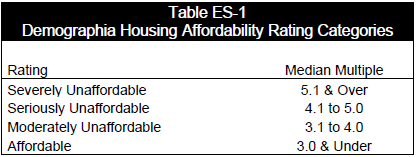
According to the Survey, Median Multiples were historically 3.0 or less in Australia, Canada, Ireland, New Zealand, the United Kingdom and the United States – a notion supported by the below chart from the Reserve Bank of Australia (RBA):
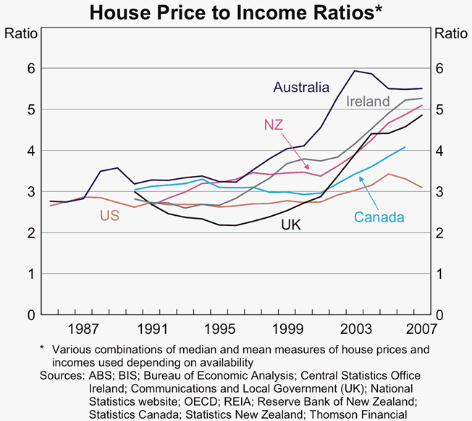
Whilst this affordability relationship is currently present in many housing markets of the United States, Canada, and Ireland, the Median Multiple has escalated sharply in the past decade in the other housing markets covered in the Survey (Table ES-4).
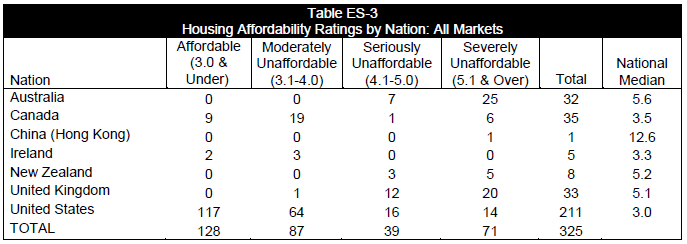
Of the 325 housing markets surveyed by Demographia, a significant proportion of the unaffordable markets are located in Australia, with 25 ranked as “Severely Unaffordable” and seven “Seriously Unaffordable”. Australia currently has no housing markets ranked as “Affordable” or “Moderately Unaffordable”.
However, since Australian house prices have fallen over the past year, Australia’s Median Multiples have fallen slightly relative to the previous survey, with two markets (Canberra and Toowoomba) graduating from “Severely Unaffordable” to “Seriously Unaffordable”. Australia’s overall Median Multiple – based upon the 32 markets in the survey – has also fallen to 5.6 from 6.1 in last year’s Survey (see below chart):
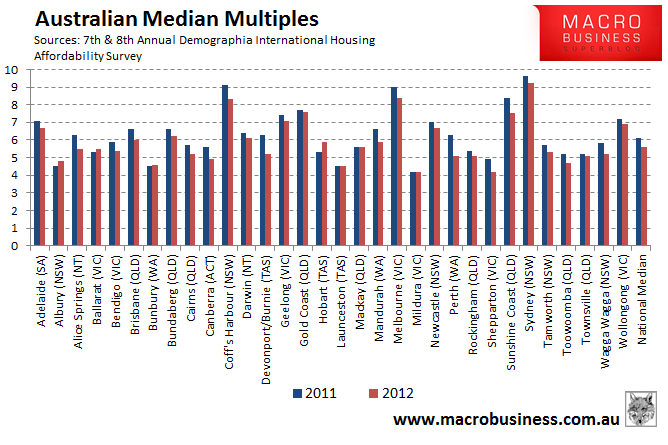
Hong Kong (China) and Vancouver (Canada) have the Survey’s most expensive housing markets, with Median Multiples of 12.6 and 10.6 respectively. Sydney, Australia (9.2), Honolulu, United States (8.7) and Bournemouth, United Kingdom (8.7) round out the top five.
Overall, Australia has moved down the league tables, registering 9 out of the 20 most expensive housing markets identified in the Survey, but only one market (Sydney) in the top five:
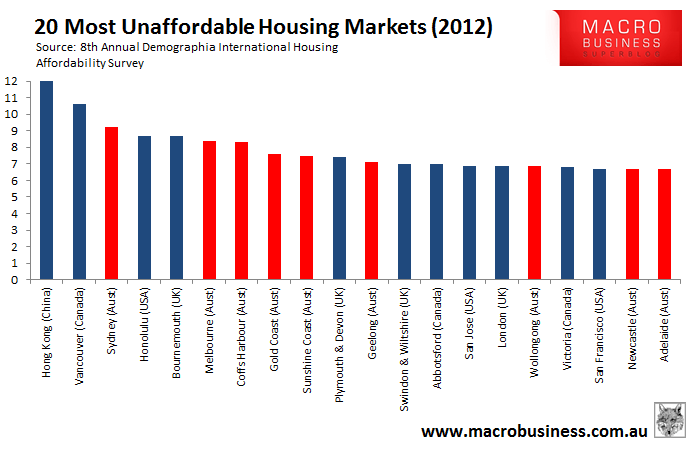
This compares to last year’s Survey where Australia also had nine of the 20 most expensive housing markets, but three of the top five:
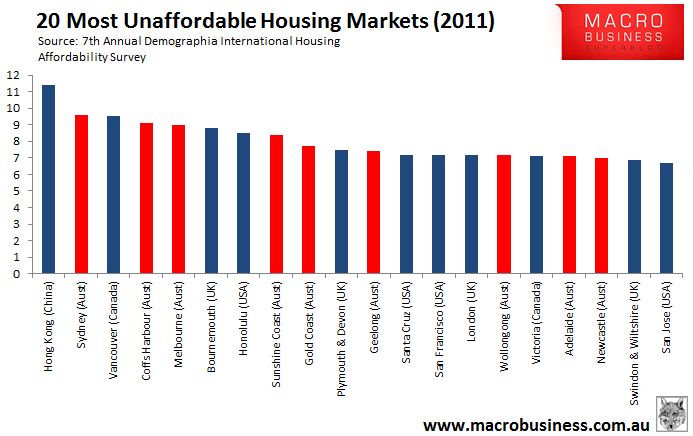
The overall decline of housing affordability in Australia (and the modest recent improvement) is clearly evident in the below Demographia chart, which shows the change in Median Multiples in Australia’s major urban markets:
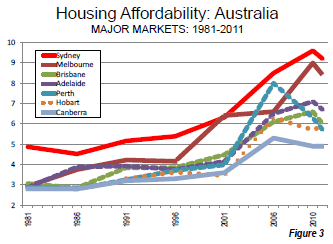
Whereas all major Australian markets, except Sydney, had Median Multiples of three in the early 1980s, today all are ranked at around five or above.
Further, this deterioration of housing affordability has occurred without regard to market size or demand, with prices in slow growth areas such as Hobart and Adelaide, as well as regional areas, exploding over the past 15 years (see below RBA chart).
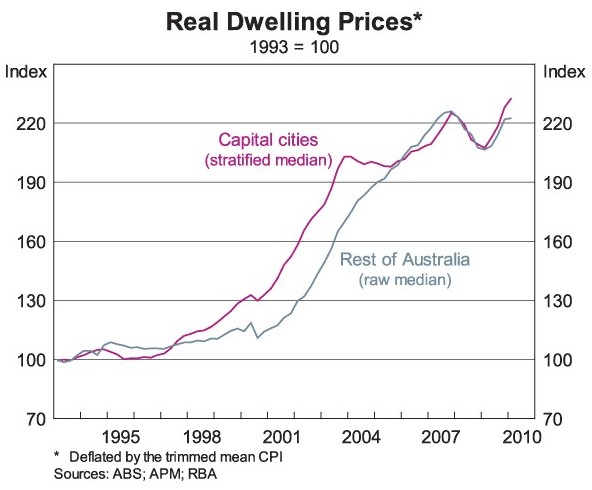
One of the key contentions of the Demographia Survey is that higher land prices are the principal contributor to the rapidly increasing home prices in unaffordable markets. These land prices include the cost increasing influence of land supply restrictions (such as urban growth boundaries), excessive infrastructure fees and other overly strict land use regulations:
The economic evidence indicates that this trend [declining housing affordability] is strongly related to the implementation of more restrictive land use regulations, especially measures that create scarcity in land for housing. In creating scarcity, more restrictive land regulation increases land prices, which increases house prices. In considering this process, economist Anthony Downs, of The Brookings Institution in Washington. D.C., has indicated the importance of maintaining the “principle of competitive land supply.” This is particularly important because one of the most favored more restrictive land use policies is the “urban growth boundary,” which prohibits development on considerable amounts of land that would otherwise be developable, resulting in artificial and unnecessary scarcity values.
More restrictive regulation has led to situations where “across the road” values per hectare of raw, developable land vary by more than 10 times in Auckland and Portland, based upon whether they are inside or outside the urban growth boundary. These “urban echo values” (pricing in anticipation of future urban zoning) are generally substantially higher again, than the true rural values, further out from the urban boundary. Even larger differences have been documented in the United Kingdom’s Barker Report and researchers at the London School of Economics.
And in last year’s Survey, Demographia noted the following about Australia:
In Australia, 95 percent of the increase in inflation adjusted new house (and land) costs were attributable to land, rather than construction from 1993 to 2006. In more restrictively regulated San Diego, house prices were 250 percent higher than in Dallas-Fort Worth in 2007, yet cost only 15 percent more to build…
Demographia’s contention that Australia’s rising home prices have been caused primarily by escalating land costs is supported by evidence. As the below RBA chart shows, the lion’s share of the rise in Australia’s home prices has been due to rising land costs rather than higher building costs:
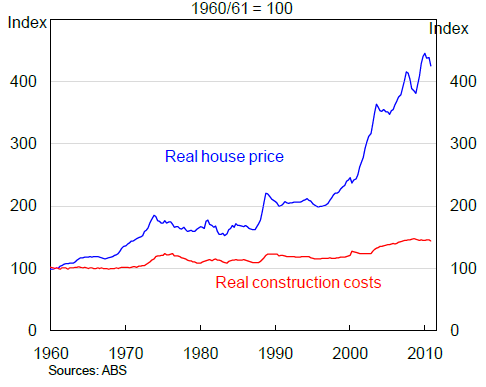
Further, when the Australian Bureau of Statistics’ (ABS) aggregate residential land values data is combined with the RBA’s dwelling values data – which combines both residential land values and structures (buildings) – it becomes clearly evident that the uplift in Australia’s housing prices over the past 20 years is due almost entirely to increasing land values, rather than higher building costs:
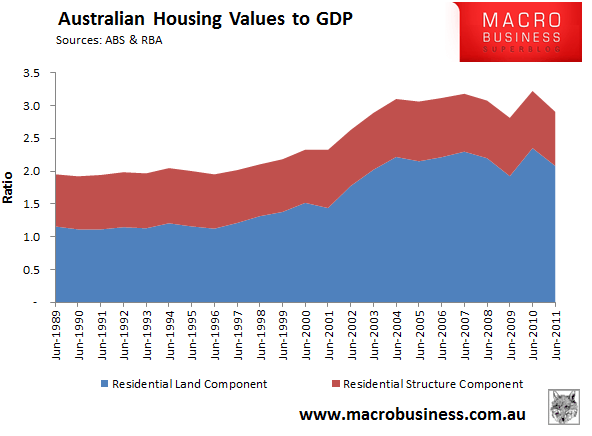
Whereas the structure values to GDP – calculated by deducting the ABS’ residential land value figures from the RBA’s dwelling assets data – was 0.8 times in 1988-89, it was only 0.83 times in 2010-11 and has remained relatively stable throughout the entire 22-year period.
Reflecting the fact that residential land has risen in value relative to buildings, the land component of Australia’s housing stock rose from a low of 57% in 1992-93 to a high of 73% in 2009-10, and has since declined marginally to 72% in 2010-11:
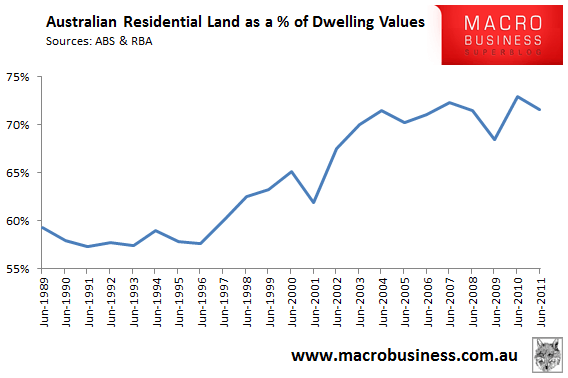
A key reason for this land price escalation in Australia (as well as in New Zealand, the United Kingdom, and the expensive markets of the United States and Canada) is that the market’s ability to quickly provide low priced new housing supply is being hampered by restrictive land use regulations, many of which have come into effect since the mid-1990s (Sydney has had long-standing limits on housing development on the urban fringe). Demographia describes the key features and consequences of restrictive housing markets as follows:
More Restrictive Markets (also called “prescriptive markets”) rely on comparatively intrusive land use regulation, and include markets where residential development (new construction) is strongly controlled or driven by comprehensive plans or with extensive limits on development imposed at various levels of government. More restrictive land use regulation are also referred to as “compact development”, “urban consolidation”, “growth management” “and ” smart growth.” Generally, more restrictive land use regulation is “plan-driven,” as planners and governments determine where new housing is allowed to be built. As a result, there is a “negative presumption,” with respect to development: Development is generally prohibited, except in limited areas where it is permitted by government plans. By severely limiting or even prohibiting development on the urban fringe, more restrictive regulation can make the “supply vent” inoperative where demand for new housing exceeds supply, which retards housing affordability.
By contrast, affordable housing markets, like Texas and Georgia in the United States, utilise open market-based land use structures whereby plentiful new housing supply is able to be built quickly and cheaply on the urban fringe, thereby preventing rapid house price escalation. Demographia describes these markets as follows:
Less Restrictive Markets (also called “responsive” markets) are all markets…[where]…residential development is allowed to occur based upon consumer preferences, subject to reasonable environmental regulation. Generally, less restrictive land use regulation is “demand-driven”. There is a “positive presumption” that land can be developed, except in limited areas, such as parks and environmentally sensitive areas. By allowing development on the urban fringe, less restrictive land use regulation allows the “supply vent” to operate, which keeps house prices affordable.
So under an open market-based model (provided there are not also substantial physical barriers to housing supply), increased demand, such as from reduced lending standards and easier availability of credit, quickly leads to the building of additional low priced housing on the urban fringe, which helps keep house prices in check and reduces the likelihood of speculative housing bubbles developing. Further, highly leveraged speculators are less likely to be encouraged into open land markets, since there is little prospect of achieving strong capital gains. Investing in open land markets is, instead, more about rental yield.
In summary, the Demographia Survey argues, convincingly, that Australia’s housing affordability problems are caused, to a large extent, by artificial restrictions on where new homes can be built. When combined with demand-side drivers – such as easier credit (fuelled by heavy offshore borrowings by the banks), overly generous tax concessions (e.g. negative gearing), high immigration, first home owner concessions, and baby boomer wealth accumulation – Australia’s strict land-use policies have inevitably caused land prices to escalate, encouraging speculation and the development of Australia’s current housing bubble.
The big losers under this socially regressive system are younger and lower income Australians who are either required to take on prohibitive amounts of debt in order to enter the housing market, or are locked-out of home ownership altogether.
That said, property enthusiasts should not necessarily view Australia’s restrictive urban planning structure as a one-way bet for house prices. Demogrphia also notes that unresponsive land supply is more likely to result in higher levels of house price volatility and boom/bust price cycles. Why? Because strict land-use policies (planning) steepens the supply curve, which makes house prices more sensitive to changes in demand, increasing the likelihood of the housing market experiencing boom/bust price cycles as demand rises/falls.
Tight planning and unresponsive land/housing supply, therefore, does not necessarily mean that house prices will be supported; rather that price falls would be exaggerated should demand ever evaporate. Anyone seeking confirmation of this phenomenon should look no further than California, in particular Los Angeles and San Francisco.
Readers seeking further information on how strict land-use (planning) policies can impact upon housing affordability and facilitate the creation of housing bubbles are encouraged to explore the following articles:
Australian/NZ Planning Systems:
- Rethinking urban planning
- Block sizes shrinking. Blame government policy
- Beware the housing elites
- Jumping the urban growth boundary
- Why developers land bank
- NZ Productivity Commission on housing supply
- Auckland embraces unaffordable housing
Lessons from the United States:
- The truth about the US housing market
- Preventing housing bubbles
- How Las Vegas gambled and lost
- The Texas housing miracle
- Look to Texas to solve Australian housing supply
Lessons from Europe:

